

| A recent history of the Dingy and Grizzled Skippers in Nottinghamshire |
| ..... |
| A number of years ago on
www.eakringbirds.com, we published an historical review and modern atlas
of Nottinghamshire butterflies. This page is something of a rework, or
perhaps a bitesize account of two particular species of butterfly. These two particular butterflies have done well over the past 30 or so years. During that time they increased their Nottinghamshire range, although progressing at very different rates. Of the two species, it is Dingy Skipper Erynnis tages (Linnaeus, 1758) which has showed a much greater ability to move into and quickly colonise new areas and has made great use of most of our former Colliery sites. It has done extremely well since the 1990's and continues to do so. The Grizzled Skipper Prygus malvae (Linnaeus, 1758) has also done very well, but has needed considerably more help to make real progress deeper into the county than it's colonising counterpart. Work parties clearing scrub along several disused south Nottinghamshire railway lines, have no doubt aided the Grizzled Skipper's path to success. |
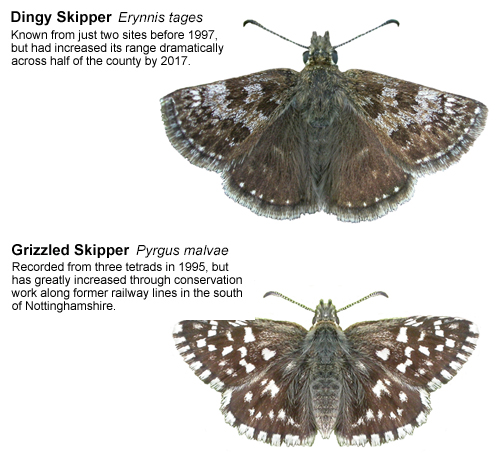 |
| ... | ||
| A very pleasing
aspect regarding the success of both these butterflies, is that
their movement and colonisations of new sites have occurred naturally. There's been no
reintroductions of either species and no release schemes to
instigate such success. Although some cynical observers might
suggest that work parties have technically interfered with the
Grizzled Skipper's progress, I would suggest that work parties have
purely created the right habitat for the butterfly to move into, rather than
it be released where it previously didn't occur. It should be noted that Dilys nor myself have, never have had any problem with the numerous releases that have taken place over the years. Its just nice when a species' success is natural, especially when it goes against all the doom-ridden stories printed in the media by conservation organisations. Many butterflies have actually done very well locally for many years. |
||
| ... | ||
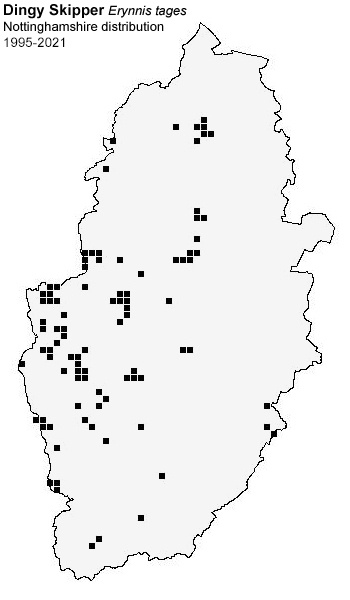 |
The Dingy Skipper's
rise to success in VC56 Nottinghamshire
Initially described by J.W. Carr in 1916 as being 'local and rare' Carr then goes on to relate that 'it was taken near Mansfield in 1859 and 1860 (Brameld). From the Mansfield district, it was fairly common in Spring', with Carr giving May 1893 given as a particular example. Carr also states that specimens were occasionally taken in the Autumn, so was obviously referring to an occasional and partial second brood in warmer years. After initially describing Dingy Skipper as being 'local and rare' in 1916, nearly twenty years later, Carr is more positive on its status within the county, stating that 'this butterfly seems to be increasing its numbers in Notts'. He adds that 'Mr Crossley reports it as abundant about Cotgrave from 1920 to 1923 and I have seen it in some numbers in several localities near Owthorpe in late May and early June 1925-1926'. Carr then adds a final record from Wigsley Wood in 1934. Current distribution and status Previously very scarce and bordering on being very rare in Nottinghamshire, Dingy Skipper has rapidly increased its range since 2003, utilising the remaining network of former mineral railway lines to spread eastwards across the county. Now found at most (if not all) of the county's former colliery sites including Annesley, Annesley-Bentinck, Bestwood, Bevercotes, Bilsthorpe, Calverton, Clipstone, Crown Farm, Gedling, Linby, Newstead, Ollerton, Rufford, Shirebrook, Silverhill and Warsop Main. Prior to 1995, the Dingy Skipper was known only from sites at East Leake and along the Teversal Trail, but in 1997 it was found for the first time close to the Derbyshire border at Bennerley Marsh. This represented only the third known locality for Dingy Skipper in Nottinghamshire and it has since gone on to dramatically increase its range eastwards across Nottinghamshire towards the Trent Valley.It first showed a pronounced population increase in 2010, when there were rises in both the number of reported records and sites across the western-half of Nottinghamshire. Two less productive years followed, before a huge increase in records occurred in 2012 and another more recently in 2017 following two less productive (but still historically notable) years. |
|
| ... | ||
| There is no doubt that the Dingy Skipper's success has coincided with the demise of the county's coal industry and possibly the increased frequency of much milder Winters over recent years. The butterfly's liking for brownfield sites left after the cessation of coal production, seems in part, to rely those sites having areas which have not been landscaped and grassed over. The Dingy Skipper shows a clear preference for areas where the vegetation is sparse and Bird's-Foot Trefoil has been allowed to develop naturally at such sites. | ||
| ... | ||
|
||||||||||||||||||||||||||||||||||||||||||||||||||||||||||||||||||||||||||||||||||||||||||||||||||||
| ... | ||
| At the former Gedling Colliery (apparently now a
country park) Dingy Skipper can be found in small,
clearly separated colonies at the base of the former
colliery's south-facing spoil heaps. In a 2016 survey, we
found the greatest concentrations of Dingy Skippers to be
where Bird's-foot Trefoil was growing in areas where the
grass and other vegetation was short, or still sparse and
where some scrub provided shelter and they particularly
favoured available hollows, banks or dry ditches. The survey produced a minimum total of 32 Dingy Skippers on 19/05/16, with the strongest populations being found along the bank and drainage ditch, directly above two shallow lagoons. Another good population was found on disturbed ground close to the site's Methane Plant, after just one Dingy Skipper was recorded from the same survey area in 2014, which provides an indication at how quickly the butterfly can establish itself at a site. However, since those surveys, work on constructing a new relief road running from Mapperley and bypassing Gedling village to Burton Joyce has been underway and is due to open sometime late in 2021. As a consequence, much of the lower reaches of the site are now lost, but the new banks either side of the road should provide excellent habitat within a year or so of completion. |
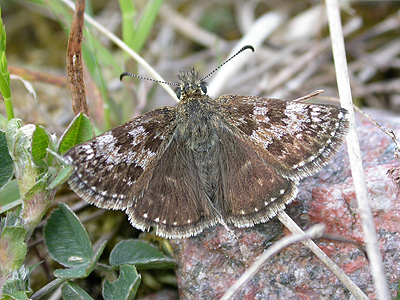 |
|
| ... | ||
| Although
there are several April records with April 18th 2017
being the earliest county record, the Dingy Skipper's
main flight period is during May and continuing into June
with numbers becoming less. The latest date for Dingy
Skipper in Nottinghamshire is July 7th 2013. The Grizzled Skipper in Nottinghamshire Historically, J.W. Carr summarises Grizzled Skipper in Nottinghamshire as being 'local and rare, except in localities south of Nottingham. In terms of actual records, he lists Grizzled Skipper from 'Newstead 1883 (Wright) and being occasional at Southwell, Wellow (Becher) and Langford Moor. It was often and common on the Fosse Road (the A46) and lanes about Cotgrave, Owthorpe and Widmerpool. Further quoted sites includes Bunny Wood, Plumtree, Gotham and West Leake Hills (Carr) and from Oxton and Epperstone' (Saunt). |
| .... |
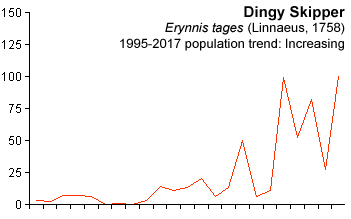 |
|
|
| ...... | ||
|
Later records listed by Carr in the 1935 Supplement to his original book, gives several later records and states that Daws recorded it 'in fair numbers near Mansfield in 1920'. We believe that the location may relate to Theives Wood, as most of Daws' records seem to originate from either there, or Harlow Wood. Other records from Carr's Supplement include Roe Wood, Winkburn, where it was 'rather common in May 1922 to 1925' and Borders Wood Owthorpe in June 1925. |
||
| ...... | ||
|
Another butterfly which has increased in the county in recent years, largely through the efforts of volunteers carrying out scrub thinning work along disused railway lines in the south and south-east of Nottinghamshire. The main areas of occurrence are along disused railway lines running from East Leake north to Rushcliffe; along the Bingham Linear Walk from mid-way between Langar and Plungar north-west to Bingham and Saxondale and from Staunton northwards past Cotham towards Newark. In 1995, the Grizzled Skipper was known from just three Nottinghamshire tetrads. This increased to ten the following year, when there were additional records from East Leake, but also from new sites at Barnstone and further north along the same disused railway line at Saxondale.1996 also saw the first of a number of records reported from along another former railway line at Kilvington and Cotham. So by 1997, Grizzled Skippers were now appearing to rapidly colonise Nottinghamshire via three former railway lines. Remembering that at the time (and with Grizzled Skipper still being a rare and relatively new butterfly to Nottinghamshire) the rate of spread along the three former railway lines, may have been slightly distorted by the suddenly increased number of recorders trying to see Grizzled Skipper in the county for the first time. In 1997, there was a small but notable peak in the number of records provided to the county recorder, before the number of records gradually dropped, leading to an apparently blank two year period in 2007 and 2008. Since then, the Grizzled Skipper has generally done extremely well, although it seems prone (as do most species) to occasional bad years following several years of relative abundance. Bad years are most probably influenced by climatic conditions and 2016 seems to have been a good example in which Grizzled Skipper numbers were poor. This butterfly does seem prone to misidentification and a cluster of records from Newstead and Annesley Country Park in the west of the county, had been thought dubious by some observers, but have been confirmed and also seen by someone visiting the site from Butterfly Conservation. At the time of writing (early April 2018) this remains the only former colliery site on which Grizzled Skippers have been reported, but all records have apparently been reported by the same observer and have to be regarded as suspect. They were first noted in 2005, but then not seen again until several reports in 2013, but apparently not since. This could indicate two possible attempts at captive-bred releases. |
|
|
| ...... | ||
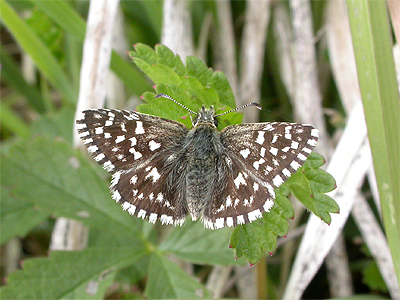 |
There does seem to be a wealth of suitable Grizzled Skipper habitat on many former Colliery sites and release schemes may be worthwhile. There seems (so far) to be little evidence that Grizzled Skipper is able to make the flight from present habitat to new habitat, as Dingy Skipper is easily able to do. Relatively near to Newstead and Annesley Country Park, there has been a claim of Grizzled Skipper from the Kingsway Park area of Kirkby-in-Ashfield. However, the record is dated as July, which is really too late for Grizzled Skipper and has to be questionable, as perhaps do two other records from the north of the county, which are not showed on the distribution map. These refer to single records from Parish Park Reserve (part of the Idle Valley NR complex) in 2014 and Shireoaks Woodlands (the former Shireoaks Colliery) in 2015. Both are isolated occurrences, occurring well away from any of the county's other Grizzled Skipper sites. Grizzled Skippers arising from released stock is a likely possibility for the Shireoaks record. Misidentification with the day-flying moth Latticed Heath (Semiothisa clathrata) is unlikely and certainly the recorders of the Parish Park record were certain of their original identification. |
|
| ...... | ||
| The earliness of the flight season is totally dependant on the Spring weather, but the first Grizzled Skippers usually begin to appear from the last week of April. May is the main flight period and the season is largely over by mid-June. | ||
| ... | ||
|
||||||||||||||||||||||||||||||||||||||||||||||||||||||||||||||||||||||||||||||||||||||||||||||||||||
| Butterflies |
| Homepage |